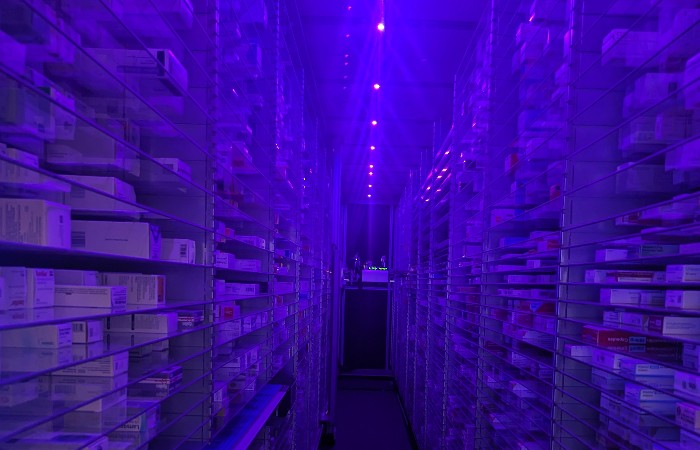Automated dispensing – luxury or necessity?
In Business news
Follow this topic
Bookmark
Record learning outcomes
In his latest diary entry on his installation of a Meditech robot, Fin McCaul talks about his experiences so far with the technology and how it is automating his dispensing process...
The shift in stock management at Prestwich Pharmacy has resulted in improved efficiency across the board, allowing my team to locate and retrieve items faster and increase the number of prescriptions they can fulfil in a day.
We decided to go for the MT-XL by Meditech. Measuring 10m in length x 2.7m tall and 1.4m wide, it comfortably stores 17,000 packs at any one time. Our old system stored about 12,000 items despite being slightly smaller than the MT-XL.
The storage ability is also reflected in the types of packs as Meditech uses a gripper system rather than a suction system. As a result, we have no issues with small packs or the security split box ends currently in use by manufacturers to support the Falsified Medicines Directive.
Understanding what you need when planning your robot is critical. We analysed our dispensing mix and discovered over 50 per cent of our pack volume came from less than five per cent of our lines. So, we opted to include the MT Speed; 160 channels that can deliver literally hundreds of packs in seconds.
Needless to say, we are not that busy but using the channel system as part of the solution has enabled the robot to deliver what we need, when we need it. To put it another way, the channels deliver the fast-moving lines, while the normal picking head is simultaneously picking the rest of the lines.
On paper, the picking head can do 250 journeys an hour. In reality, this equals a significant number of items. as we have observed it picking up to five packages of different sizes in one batch before delivering to the output and returning for more. This feature and the speed channels have dramatically increased the speed at which we can complete prescriptions, single or multiple items.
Image: The inner workings of the Meditech robot at Prestwich Pharmacy.
The combination of the single picking head and the channel system enables the storage of products and replenishment of the speed channels during normal daytime operations. This has been a game-changer for our stock management, as stock is continuously replenished when space becomes available through the day.
Historically, the robot could not keep up with the staff as they labelled, so much so that they were manually retrieving fast-moving lines. Now, all the products arrive as they are dispensing, saving time and energy as well as keeping our dispensary more organised and stocked.
One of the biggest concerns we had initially was the speed of loading into the robot, especially as we only had two or three days to load as much of the stock as possible before we went live. The reality was that between Friday lunchtime and Monday morning, we managed to get over 12,500 packs into the system, as well as train the staff.
We had team members scanning on to the belt but critically, the Optimat (system to sort, scan and input packs) worked away, even when we were not in the pharmacy. Virtually all the stock is entered using the 2D barcode which enables the additional benefit of export date management – the robot will automatically output any short-dated stock at a time we set.
Automating this crucial element of pharmacy operations can revolutionise a business. Removing this responsibility from your staff creates a higher level of focus, leading to fewer mistakes and an improved service overall. We’ve already noticed shorter wait times for prescriptions and an increase in output each week, despite having fewer and less experienced team members than we had a year ago.
It’s almost inevitable that with any system, things will go wrong. With most systems on the market, the robot stops and beeps at you to come and see what the issue is but what has amazed me is how the robot handles errors. If there is an issue with picking from the shelf, the robot marks the box and shelf position as an error before finding another pack to fulfil the initial request.
When a number of issues build up (five or so), it presents you with an opportunity to resolve them on-screen. If you delay and too many build up (15-20), it slows production until they are resolved – but all the time prioritising delivering medicines to any PMR requests.
As our dispensary team leader Vicki enthused: “This robot hardly ever needs assistance and it gives details on-screen if there’s an error, so we can quickly resolve it.” Another member of my team said: “It makes my life easier! It dispenses faster, doesn’t beep all the time and it’s so easy to navigate the software.”
The robot can also continue functioning through most minor errors, so we aren’t halting operations completely when there is a rare error.
Automating our operations may not have been a necessity 17 years ago but it is now. The speed, intelligence and reliability of the Meditech robot has renewed my faith in human-driven, robot-assisted dispensing at my pharmacy.
Since the installation, we’re seeing shorter waiting times for patients, increasing numbers of items dispensed daily and smarter stock management. I’ll leave it to you to decide whether you consider that a luxury or a necessity in your business.


